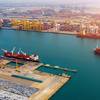'Free Money' is Over, but Shipping Finance is Positive
Shipping finance markets for the rest of 2023 look positive, with a depth of lenders, banks, leasing houses and alternative credit funds all seeking to grow their portfolios and offer the best terms to win projects; and competition between lenders in the improving tanker markets is especially fierce, says a recent survey from oceanis.
While financing volumes available for each individual vessel have plateaued as asset values rose over the past quarter, margins have been under severe downward pressure as banks have started to explore financing cases further from their previous comfort zones. Meanwhile, opportunities remain in the less liquid dry bulk and container markets.
“Base interest rates, while currently high, are projected to fall from the second half of 2023," said Erlend Sommerfelt Hauge, Managing Partner at oceanis. "While the ‘free money’ era has ended for now, financing costs can be expected to decrease in the near to medium term as central banks react to the decreasing inflation we are seeing today as well as being spooked by the financial turbulence triggered by higher base rates.” Here's a look at some key sectors.
- Tankers
'Huge volatility' is the hallmark of Q1 in the tannker sector. While rates dropped around the 5 February cut-off date for EU shipments of Oil products, the recent rebound has proven that the market remains resilient.
Asset values continue to race upwards, and have now detached somewhat from current earnings, leading financiers to reduce their maximum LTV (loan-to-value) offerings both for vessels with and without long-term employment.
While in January it was possible to arrange 70% Loan-To-Cost for 16-year-old spot-trading MR (Medium Range) tankers on a non-recourse basis, with similar terms available for vessels from Handysizes up to Aframaxes, the dollar value of the financing available seems to have plateaued at this level. Now, with the same dollar amount being equivalent to circa 65% leverage, this is the upper limit on leverage without employment for older vessels.
From a financing perspective there is a feeling that this market is now similar to the container market of 2021, where the majority of the financial analysis is related to the charter rate, duration and counterparty quality, with loans amortising to $0 or a low scrap value for older vessels under such fixed employment.
- Dry Bulk
After more than a year of steady decline, dry bulk markets seem to have finally bottomed out, as earnings have rebounded across the sector.
While there remains a strong belief from shipowners that the long-term rates currently available are well below the spot rates which will be realized in years to come, financiers are constrained by currently realisable earnings and in several cases this has resulted in reduced financing amounts. oceanis sees this as being particularly important for alternative debt funds, where the ability of these more expensive financiers, in comparison to conventional banks, to provide additional capital is limited by the need to maintain positive cashflows. Some debt funds can structure repayments around this issue, offering an increased financing volume against the security of an additional pool of pledged cash, but this is far from common.
- Containerships
With charter-free market values returned to pre-pandemic levels, and earnings higher than during those pre-pandemic times, the financial world is resuming loan provision to vessels with less fixed employment and those on charter to lower tier counterparties. German borrowers in particular are able to take advantage of highly attractive terms for acquired vessels with outstanding charters, with financing at 65% LTV yielding margins in the mid-3% region when employed long term to a Tier II charterer.
There remain serious questions over the long-term earnings of older vessels in the spot market, which is reducing lender willingness to provide funds for acquisitions without firm employment, resulting in lower LTVs becoming more frequent.













